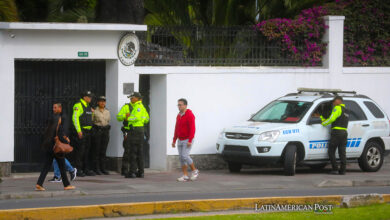Ecuador and Coronavirus: (un) expected crisis
Here is a summary of the situation Ecuador is going through in the midst of the global public health crisis.

Ecuador faces one of the worst scenarios due to COVID-19. / Photo: Pixabay <
LatinAmerican Post | Staff
Listen to this article
Leer en español: Ecuador y Coronavirus: crisis (in)esperada
Ecuador is one of the countries that has seen the COVID-19 infection curve grow the most since the virus reached Latin America. Its situation is unfortunate and its health system is weak.
Without a doubt, the situation in Ecuador is alarming and impressive. Much has been said and speculated about why the case of this country stands out above that of the other Latin Americans and how the accelerated speed at which the number of infected Ecuadorians grows can be contested. Here we summarize what has been said on the subject.
Some figures: what is the current situation in Ecuador?
At the time of writing this article, Saturday, April 4, Ecuador has a total of 3,465 infected with COVID-19 and 172 have died from the virus. However, this past Thursday, April 2, the president of the aforementioned country, Lenín Moreno, confessed that the official figures may not give a real look at the situation in Ecuador:
"We know that both in number of infections and deaths, official records fall short. Reality always exceeds the number of tests and the speed with which attention is given", he said in a message that was transmitted to all Ecuadorians.
This is alarming not only due to the fact that the numbers of infected and deceased people are not fully known, but also because with what is already known, the official figures are highly remarkable above other Latin American cases. How come they don't know well? As the Ecuadorian president said, the official figures are not necessarily a reflection of reality, why is this? It should be considered the number of tests for COVID-19 that have been carried out in each country. Thus, it can be said that Ecuador, which until April 2, according to the BBC, had carried out no more than 10,000 tests, does not have the complete scenario of the number of infected.
¡Más decisiones para enfrentar el #Covid19!
-Se mantiene la jornada laboral en los términos actuales hasta Abril 12.
-Implementaremos un semáforo con restricciones de movilidad por provincia.
-Las clases y la movilización interprovincial seguirán suspendidas durante este mes. pic.twitter.com/WkXe91i4M1— Lenín Moreno (@Lenin) April 2, 2020
Guayaquil: scene of tragedy
This is reflected in the dramatic case of the Guayas region, where the city of Guayaquil remains, which to date has more cases of infection than entire countries in Latin America. Since authorities do not really know how many people are infected at the moment, it is difficult to keep track of how many of the deceased currently in the city of Guayaquil are due to the pandemic virus.
This has caused a collapse not only in the health system but in the funeral system, as it is no longer sufficient to attend to the number of deaths that take place in this city. According to Semana, President Lenín Moreno has even gone as far as suggesting burials in mass graves in case the situation gets even more out of control.
Why Ecuador?
Many wonder, then, why Ecuador became so fast in a center of the pandemic and why its case stands out above other Latin American countries. For this, the measures that were taken and the time they were taken must be considered.
The first case reported in Ecuador of COVID-19 was on February 29 of this year. This made this country the third in Latin America to which the virus reached, so it can be assumed that COVID-19 has been incubating there for more days. President Lenin Moreno declared a state of emergency as of March 16, two weeks later, and that has been the government's position ever since.
Also read: How LATAM would cope with the Coronavirus recession
At this moment, Ecuador is the second country in Latin America that has the most infected people with COVID-19 after Brazil. However, Ecuador has 12 times fewer inhabitants and is 30 times smaller in territorial terms. Thus, Ecuador is currently the country in Latin America that presents the most cases by number of inhabitants and by square meter of territorial area.
In an attempt to explain why the case of Ecuador is so dramatic, the new health minister Juan Carlos Zevallos (another explanation may be the radical resignation of the previous minister, Catalina Andramuño, last Friday, March 27), told the BBC that the population would not have helped with the preventive measures and that the consequences were seen now, a few weeks later.
Esteban Ortiz, an epidemiologist, also explained to the BBC that the connection with Spain, one of the contagion centers, could very well explain how the contagion got out of control in Ecuador. The Ecuadorian community is the largest within the migrant communities in Spain.
Thus, many mobilized from there to Latin America at the beginning of the year. This would also explain that the sources of contagion in the country are Quito and Guayaquil, both cities that host international airports. Case 0, in fact, involved a woman who would have traveled from Madrid to Guayaquil on February 14 and who would have been in contact with at least 180 people on arrival at social and family gatherings.
Thus, the Ecuadorian government has already lost track of those infected, because after this first siege of 180 people with whom the patient 0 had contact, it is difficult to rigorously track all possible infections.





